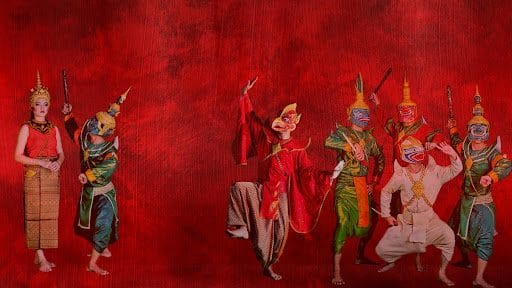In India and in Southeast Asia, no one hears the Ramayana for the first time, said the folklorist AK Ramanujan. “The stories are there ‘always already’.” Reflecting on the pervasiveness of Ramayana, Ramanujan argued that “the Rama story has become almost a second language of the whole culture area, a shared core of names, characters, incidents, and motifs, with a narrative language.” As a cultural language, Ramayana connects India and Southeast Asia in ways that nothing else does.
French historian George Coedes considered the shaping of the entire Southeast Asia by elements taken from Indian culture as “one of the outstanding events in the history of the world, one which has determined the destiny of a good portion of mankind.” While in modern times, the West came to establish a relationship of dominance and exploitation whose hallmark was racialism and assertion of cultural superiority, the reshaping of the cultures of Southeast Asia by Indic elements was an organic process of blending and creative adaptation. It is apt that the river, which has sustained civilisations in Southeast Asia, is named after the Ganges – Mekong (Me=Ma Kong= Ganga) that symbolises the unique bonds that exist between India and Southeast Asia.
Laos forms the northern part of the peninsular region that also consists of Cambodia and Vietnam. The region was part of the land that was known to ancient Indians as the ‘Suvarnabhumi’ or the ‘Land of Gold’. It has been suggested that Ashoka’s war with Kalinga was instrumental in the emigration of a number of people towards Suvarnabhumi and they brought with them Hindu and Buddhist beliefs across the seas. In any case, by the early centuries of the Common Era, strong commercial relations had been established with Southeast Asia in which traders and merchants from western, southern and eastern parts of India participated.
The Periplus of the Erythraean Sea mentions several ports like Kamara (Kaveripattinam), Poduke (Pondicherry), and Sopatma (Sopattinam of Tamil sources) as ports where large ships sailed towards the Malay Peninsula. It was from Tamralipti or modern Tamluk in Odisha that Fahien and I-tsing set sail for their return to China and which doubtless was an important starting port for traders sailing east. Brahman ritual specialists, traders, and Buddhist monks involved in this exchange of goods and ideas across the seas provided the stimulus for what Goerge Coedes called the ‘Indianisation’ of Southeast Asia. Its results were the establishment of kingdoms, emergence of written traditions, spread of Hindu and Buddhist ideas and ways of life, and propagation of epics like the Ramayana and the Mahabharata. Ramayana took such a strong hold over the cultures of Southeast Asia that a temple dedicated to Valmiki was built in Champa, the only temple of its kind in the seventh century CE.
Also read: Rama as a descendent of Adam? Inside Indonesia’s Muslim Ramayanas
Ramayana’s reception in Laos
Undoubtedly, the founding of the Lan Xang (literally meaning ‘the land of a million elephants’) kingdom in the 13th century was one of the most important factors in shaping the reception of Ramayana in Laos. Under King Phothisarath, Theravada Buddhism was placed at the centre of the Lao cultural life with its capital at Luang Prabang. It was under the auspices of the newly founded kingdom drawing inspiration from Buddhism that the national epic of Laos, Phra Lak Phra Lam (Beloved Lakshman Beloved Ram), took shape. Fa Ngum, the founder of the Lan Xang Kingdom, came with his soldiers from the Cambodian capital of Angkor and is said to have introduced this epic that came to acquire a national stature. It is because of the influence of Buddhism in Laos that Phra Lak Phra Lam came to be presented as a Ram Jataka or a Buddhist tale. An elaborate oral, visual and performative culture through dance dramas developed around the Rama Jataka in Laos under royal patronage. Buddhist temples came to be adorned with scenes from the Ramayana, one of the best being the temple of Vat Pha Khe in Luang Prabang.
While deeply influenced by Valmikian narrative, the Laotian Ramayana is also built on the template of Lao’s history and ways of life of the people. In the Rama Jataka, Ram and Lakshman are the princes of the northerly city-kingdom of Chandrapuri Sri Satta Naga (Vientiane) while Ravana, who happens to be their cousin, is the ruler of the southernly kingdom of Indraprasthnagar. The abduction of Rama’s sister by Ravana is the cause of the battle between the two. After defeating Ravana, Ram and Lakshman return to Vientiane, founding many new cities like Ayutthaya, Phitsanulok, and Nakhon Savan.
It is the second part of the Rama Jataka that bears greater resemblance to the Valmikian narrative. In this part, Sita, who is the abandoned daughter of Ravana, grows up to be a beautiful maiden who is won over by Ram much to the jealousy of Ravana. Sita is then abducted by Ravana and kept in Lanka for three years. In an epic campaign involving magical animals, monkey armies and building of a bridge over the sea, Rama finally kills the demon king Ravana and brings Sita back to Vientiane.
In its portrayal of Laotian life and values, the Phra Lak Phrak Lam, in Kamala Ratnam’s words, became a veritable repository of Lao life, cultures and habits, customs and manners, flora and fauna, geography, and the history of its men and animals.
Given the unique bonds that exist between India and Laos and the larger Southeast Asian region, it was only fitting that an Indian scholar sent by ICCR, Delhi — Sacchidananda Sahai — produced the textual version of Phra Lak Phra Lam after a diligent study of six different manuscripts in 1973. The visit of Prime Minister Narendra Modi to Laos will contribute to consolidating its deep historical linkage with a region with shared culture and heritage.
Ashwin Parijat Anshu teaches history at Zakir Husain Delhi College, Delhi University. He tweets @ashwinanshu73. Views are personal.
(Edited by Prashant)






